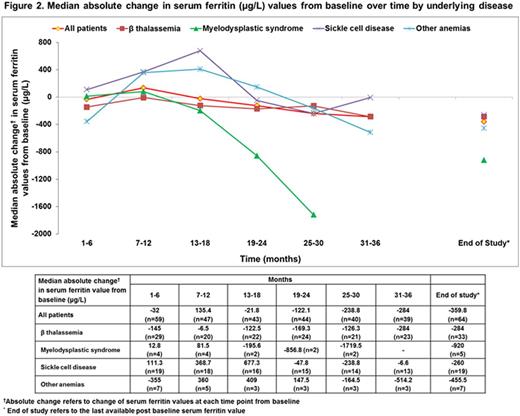Abstract
Background: Hemosiderosis, due to frequent blood transfusions, is associated with liver, heart and endocrine dysfunction. Deferasirox (DFX), a once-daily oral iron chelator is used in the management of these patients (pts). The results of the 3-year (yr), non-interventional SENTINEL study demonstrated long-term safety and efficacy of DFX in a large cohort of pts with transfusional hemosiderosis. The current analysis was performed to further evaluate the long-term efficacy and safety of DFX by age and underlying disease.
Methods: The SENTINEL study design was previously reported (El-Beshlawy et al. Haematologica 2016;101(s1):abst E1475). In this study, data were collected for 3 yrs from the initiation of treatment with DFX. Pts aged ≥2 yrs treated with DFX for transfusional hemosiderosis, enrolled according to the local prescription information, were included in the study. Safety was evaluated by regular monitoring and recording of adverse events (AEs) and is reported in all pts who received ≥1 dose of DFX and had ≥1 post baseline (BL) safety assessment (safety set). During each bi-annual time period, summary statistics are provided for the average SF values taken for each pt within that specific time period.
Results: Of the120 pts enrolled, 49 (40.8%) were diagnosed with β thalassemia, 31 (25.8%) with sickle cell disease (SCD), 21 (17.5%) with myelodysplastic syndrome (MDS), and 19 (15.8%) with other anemias. The mean±SD age was 28.9±29.0 (range, 1-88) yrs (<18 yrs, n=69 [7.5±4.2]; ≥18 yrs, n=51 [57.9±22.1]).
Overall, 42.5% (n=51; <18 yrs, n=45; ≥18 yrs, n=6) of pts completed the 3-yr study. Most common reasons for discontinuation (>10%) include pts no longer requiring study drug (19.2%), AEs (12.5%), and withdrawal of consent (10.8%).
Median duration of DFX exposure was 29.9 months (mos), (<18 yrs, 36.0; ≥18 yrs, 10.0). Mean average actual dose was 23.2±8.2 mg/kg/d (<18 yrs, 25.7±6.6; ≥18 yrs, 17.7±8.9).
Overall, 54.7% (n=64) of pts did not receive prior iron chelation therapy (ICT) and 45.3% (n=53) received prior ICT. Of the pts evaluable for average actual dose, 56.5% (26/46) of pts without prior ICT and 82.2% (37/45) of pts with prior ICT received treatment with an average actual dose of DFX ≥20 mg/kg/d. Pts without prior ICT received a lower average actual dose (mg/kg/d, mean±SD) of DFX compared to pts receiving prior ICT (<18 yrs, 23.8±5.2 vs 27.6±7.4; ≥18 yrs, 15.4±7.7 vs 20.3±9.7) (Table 1).
Of the 117 pts evaluated for safety, increase in serum creatinine, >33% above BL and the age-adjusted upper limit of normal (ULN) on at least 2 consecutive measurements (≥7 days apart) were observed in 14 pts (12%; 95% confidence interval [CI], 7.1-19.2; MDS [n=3], SCD [n=7] and other anemias [n=4]).
Increase in alanine aminotransferase (ALT), >5×ULN on at least 2 consecutive measurements (≥7 days apart) was observed in 1 pt (0.9%; 95% CI, 0.0-5.2) with β thalassemia (BL ALT missing).
DFX-related AEs gradually decreased over time (Figure 1A). Overall incidence of AEs regardless of relationship with DFX also decreased over time (Figure 1B).
In the overall pt population, the median absolute change in SF values (µg/L) from BL to last available post BL (end of study, EOS) was −359.8. In pts with β thalassemia, the median absolute change in SF values from BL to EOS was −491.0 (n=27) in pts <18 yrs and −79.0 (n=6) in pts ≥18 yrs (Figure 2).
Conclusions: Nearly, 40% of the pts received treatment with DFX for 36 mos during the study, indicating good tolerance of DFX treatment, and 45% of the pts received prior ICT. Pts with prior ICT received a higher average actual dose of DFX compared to pts without prior ICT. Pediatric pts received a higher average actual daily dose compared to adult pts, irrespective of the chelation group. The majority of pts with prior ICT received an average actual dose of DFX ≥20 mg/kg/d. Long-term treatment with DFX demonstrated a gradual decrease in SF values in the overall pt population, though this was not immediate, likely because of delayed increases in dose based on weight gain and ongoing iron intake. DFX-related AEs gradually decreased over 3 yrs and demonstrated an acceptable safety profile. This reinforces that an average actual dose of DFX ≥20 mg/kg/d might be required in majority of pts for appropriate management of transfusional hemosiderosis in actual practice.
Bruederle:Novartis Pharmaceuticals Corporation: Employment. Azmon:Novartis Pharmaceuticals Corporation: Employment. El-Beshlawy:Novartis Pharmaceuticals Corporation: Research Funding; Apo Pharma Inc.: Research Funding.
Author notes
Asterisk with author names denotes non-ASH members.




